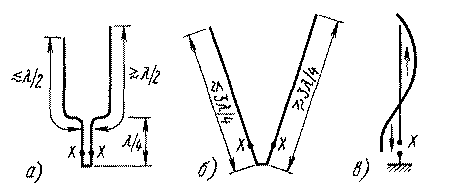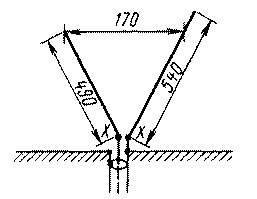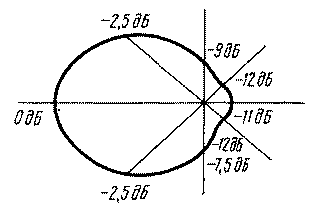DIRECTIONAL ANTENNA WITH VERTICAL POLARIZATION
Vladimir POLYAKOV (RA3AAE)
New solutions do not appear very often in antenna technology. These undoubtedly include the curious version of a two-element directional antenna with vertical polarization, proposed by Vladimir Polyakov last year. In this article, he talks about a possible modification.The description of the antenna, which is formed by two closely spaced vertical dipoles with a length of about a half-wave, fed from the lower ends through a quarter-wave two-wire line, was published in KB magazine (V. Polyakov. Vertical directional antenna. - KB magazine, 1998, No. 5, pp. 27-31). It is shown schematically in Fig. 1, a (XX - feeder connection points). Already in those experiments, it was noticed that the shape of the antenna "arms", as well as their location, are not critical. The total length of each vibrator is noticeably more influenced, which should be slightly less than З/4 λ for one of them "director", and slightly more than this size for the other "reflector". Such a difference in the lengths of the vibrators is necessary for the correct phasing of the currents in them and the creation of unidirectional radiation.

Figure: 1Why not make the vibrators straight and diverging from the base at a slight angle to the vertical, as shown in Fig. 1, b? Indeed, between their "centers of gravity", where the antinodes of the current are located, there will still be a distance of about λ/8, which is required for the normal operation of the antenna. As for the quarter-wave line, it will have a wave resistance variable along its length, which, again, is not terrible. The radiation of the diverging quarter-wave line conductors should not be significant, since they are located close, and the currents in them, in accordance with the principle of operation of the antenna, are almost antiphase (Fig. 1, c).
Experimental studies of the antenna fully confirmed the expected results - the antenna showed good directivity and turned out to be easy to set up. Some problems arose with her nutrition. At first, the antenna, like the previous one, was fed "according to science" - at points XX, not far from the short-circuited end of the quarter-wave line. The central conductor of the cable was connected to the director, and the braid to the reflector. Then the cable was laid along the reflector and went vertically down from the short-circuited end of the quarter-wave line (a point with zero potential). It turned out to be inconvenient to move the power points when tuning the antenna along non-parallel vibrators. In addition, changing the length of the vibrators and the position of the feeding points at the same time seemed difficult.
Nevertheless, the antenna worked, giving radiation directed towards the short vibrator with a gain of 4 dB compared to the half-wave vibrator. Then the antenna was fixed on a "grounded" base (a metal plane simulating the roof of a car) and it became completely inconvenient to move the power points. Then it was decided to connect the central conductor of the cable from below to the active "director" vibrator, and connect the cable braid and reflector to the base. The considerations were as follows: the input impedance of an active vibrator with a length of 3/4 λ is about 50 ohms, instead of 37 ohms for a quarter-wave, and should provide good matching. Is the reflector now passive? It seems that not, since it is resonant and is connected directly to the cable sheath, therefore, it should effectively "suck" the current from it.
All these considerations were confirmed in practice and the antenna efficiency increased by about 0.5 dB. The experiments proved to be very convenient factory television antenna - "mustache" with two telescopic elements, the ribbon cable of which was replaced with a coaxial one. The design of the resulting antenna, the dimensions of which were selected for the frequency of 430 MHz (Fig. 2), exactly corresponded to the letter V. It would be called a V-antenna, but this name has long and firmly been attached to the wire horizontal antenna. Also known - "Inverted V" antenna. By analogy, I propose to call the structure "Vertical V" antenna or W.

Figure: 2Setting it up is easy. It is only necessary, by changing the length of the dipoles and tilting them, to achieve the maximum radiation in the main direction. The signal was recorded by the simplest field indicator placed a few meters from the antenna.
The gain of the antenna is estimated at 4.5 dB relative to the half-wave vibrator (about 6.5 dB relative to the isotropic radiator). The radiation pattern in the horizontal plane (in azimuth), taken point by point at 45 ', is shown in Fig. 3.

Figure: 3Some non-uniformity of lateral radiation is explained by the influence of surrounding objects (the author did not have a "clean" antenna range for these measurements). The forward / backward radiation ratio was not too high, about 12 dB. It can be improved by pushing the reflector more forward, but at the cost of slightly reducing the gain in gain.
ON-LINE antenna element calculator
[ Home ] [ section Antennas ]
Radio N7-1999.